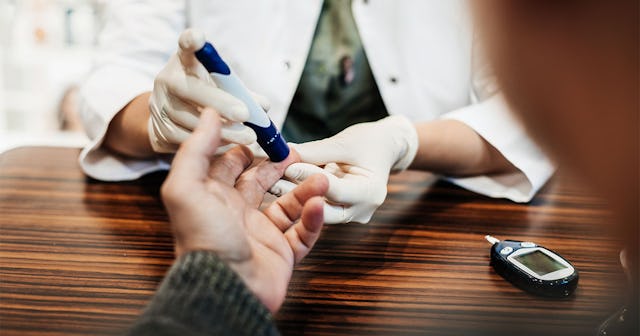COVID-19 Can Initiate Type 1 Diabetes — Here's What You Need To Know

It was right around this time, 17 years ago, that I got a stomach virus. I was sick for about three days, and I never recovered. In fact, I just kept losing weight without trying. Within a year, I went from a size six to a double zero. I couldn’t drink enough water, and I snacked constantly. My vision was blurry, my muscles ached, and I was always tired. I went to five different medical professionals who were all exasperated with me. I was misdiagnosed with anorexia and hypochondria.
Everything changed when my husband took me the ER as I slipped in and out of consciousness. I was shaking, I couldn’t catch my breath, and I was guzzling water. After an hour of blood tests and exams, I was diagnosed with type 1 diabetes—a chronic, autoimmune disease. My blood sugar was seven hundred, which is seven times the norm. I was in a state called diabetic ketoacidosis, a life-threatening condition, and I was sent to the ICU.
What terrifies me about the COVID pandemic is its potential, ongoing link to type 1 diabetes. Type 1 used to be called “juvenile diabetes,” however, we now know that type 1 can occur at any age; I was 24 when I was diagnosed. Type 1 is an autoimmune and chronic disease. Though there isn’t one set cause of type 1 diabetes for all patients, there are many theories as to why one person gets it but not another—and why it even occurs in the first place.
Along with the “why” and “who,” there’s also no cure. Instead, Type 1 diabetics must manage their disease by administering proper insulin doses and counting the carbohydrates they eat. Our pancreas doesn’t produce insulin, and without insulin, we die. You may have seen type 1 diabetics, like myself, wearing an insulin pump and continuous glucose monitoring device. This is because diabetes is 24/7/365. There’s no vacation from the disease. We can’t take an insulin hiatus.
The pandemic has brought on new concerns regarding type 1 diabetes. According to Dr. Francis Collins, the director of the National Institutes of Health, “Along with the pneumonia, blood clots, and other serious health concerns caused by SARS-CoV-2, the COVID-19 virus, some studies have also identified another troubling connection.” That connection is that “some people can develop diabetes after an acute COVID-19 infection.”
He goes on to explain. “Type 1 diabetes occurs when beta cells in the pancreas don’t secrete enough insulin to allow the body to metabolize food optimally after a meal. As a result of this insulin insufficiency, blood glucose levels go up, the hallmark of diabetes.” This is where Covid comes in. “Earlier lab studies had suggested that SARS-CoV-2 can infect human beta cells.” And that’s not all. “They also showed that this dangerous virus can replicate in these insulin-producing beta cells, to make more copies of itself and spread to other cells.”
Additional research found that “confirmed infection of pancreatic beta cells in autopsy samples from people who died of COVID-19.” If that doesn’t sound bad enough, they also found that their studies “suggest that the coronavirus may preferentially infect the insulin-producing beta cells.”
Now, just because you or your child has had COVID-19, it doesn’t mean you need to run out and buy a home glucose monitor or rush to the ER. It’s important to be aware of the connection between COVID-19 and type 1 diabetes in some people, so you can watch for the symptoms in your own family members and yourself. There’s always the risk of developing type 1, but having a recent COVID infection is another reason to keep an eye out.
According to The Mayo Clinic, the symptoms of type 1 diabetes include “increased thirst, frequent urination, bed-wetting in children who previously didn’t wet the bed during the night, extreme hunger.” Other symptoms are “unintended weight loss, irritability and other mood changes, fatigue and weakness, blurred vision.”
If a person is in diabetic ketoacidosis like I was, you will notice other symptoms. The CDC shares early symptoms of DKA include “being every thirsty” and “urinating a lot more than usual.” When DKA isn’t promptly treated, severe symptoms come on fast. These include “fast, deep breathing, dry skin and mouth, flushed face, fruity-smelling breath.” Additionally, “headache, muscle stiffness or aches, being very tired, nausea or vomiting, stomach pain.” They note that DKA can sometimes be “the first sign of diabetes in people who haven’t yet been diagnosed.”
A difficulty that some encounter is that symptoms of type 1 diabetes and DKA often mimic other conditions including strep throat, influenza, a UTI, the common cold, and even COVID itself. I’ve read countless stories of people who were misdiagnosed with a virus, which left their type 1 untreated. Some people have tragically died from diabetic ketoacidosis complications when they weren’t diagnosed with type 1 diabetes in time.
It’s important to note that diabetic ketoacidosis isn’t a wait-and-see situation. DKA is a medical emergency that requires prompt, correct treatment in order to prevent serious illness or death. If a person is exhibiting the symptoms of DKA, it’s critically important that they seek medical help immediately. It’s perfectly reasonable to insist that the patient’s blood sugar be tested before being released by the medical professional. My motto: better safe than sorry.
The more we learn about long-haul COVID, the more I am hopeful we also learn more about the link between COVID and type 1 diabetes. Certainly, this pandemic has thrown—and keeps throwing—many curve balls. Type 1 diabetes is yet another reason to take coronavirus seriously.
This article was originally published on